Introduction
Recovery of Dietary Nitrogen in Milk
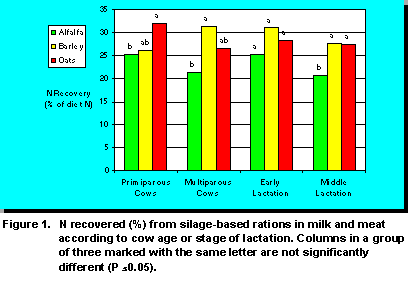 The lower the concentration of N in the
manure, for example, the less the potential for nitrate pollution of water and the smaller
the land area required to spread the manure. (The draft recommendations for manure
management (7) state "manure application rates plus those of purchased nutrients should
not exceed the nutrient requirements of the planned crop"). Because N, or protein, is a
costly component of rations, feeding costs may also be decreased. The N efficiency of
cows in early or mid-lactation associated with diets tested at the Dairy Unit of the
Edmonton Research Station was calculated (Figure 1) using data from published
experiments (16). Diets of 50:50 concentrate:silage (DM basis) were fed for 84 days to
20 cows, 12 multiparous and 8 primiparous, in early lactation; and to 24 cows, 16
multiparous and 8 primiparous, in mid-lactation. For each cow we used values of intake
of CP, production of milk protein, and change in body mass to calculate N efficiency:
The lower the concentration of N in the
manure, for example, the less the potential for nitrate pollution of water and the smaller
the land area required to spread the manure. (The draft recommendations for manure
management (7) state "manure application rates plus those of purchased nutrients should
not exceed the nutrient requirements of the planned crop"). Because N, or protein, is a
costly component of rations, feeding costs may also be decreased. The N efficiency of
cows in early or mid-lactation associated with diets tested at the Dairy Unit of the
Edmonton Research Station was calculated (Figure 1) using data from published
experiments (16). Diets of 50:50 concentrate:silage (DM basis) were fed for 84 days to
20 cows, 12 multiparous and 8 primiparous, in early lactation; and to 24 cows, 16
multiparous and 8 primiparous, in mid-lactation. For each cow we used values of intake
of CP, production of milk protein, and change in body mass to calculate N efficiency:
where Dietary N is the average daily intake of CP divided by 6.25, and Milk N is the average daily production of milk protein divided by 6.25. Tissue N is calculated from the average daily change in body weight (DBW) according to the equation:
where 0.3 is the DM of body tissue, 0.7 is the protein content of body tissue, and 6.25 is a conversion factor (protein/6.25 = N). Milk production did not differ significantly between cows fed alfalfa or cereal silages. If these results are extrapolated to a 305-day lactation, the amount of N excreted would be about 170 kg from mature cows fed rations with alfalfa silage, but only about 115 kg from mature cows fed barley silage. Feeding cows to optimize the recovery of feed nutrients in milk is thus the first step to environmentally and economically sustainable management of manure.
Current Use of Manure Nutrients
We used data from the 1991 Canada Census and data summarized by Snowy Owl Software for the CAESA Water Quality Monitoring Committee (14) to calculate the supply and distribution of manure nutrients in municipal regions of Alberta. To estimate the quantities of N or P excreted, we applied published nutrient production factors (19,20) to the numbers and kinds of animals from the census data. Using this estimation approach, in 1991 livestock in Alberta excreted 271,000 tonnes of N and 79,000 tonnes of P, compared to 308,000 tonnes of N and 57,000 tonnes of P purchased as fertilizer. Since 1974, then, the estimated amount of N excreted by livestock has increased 4.4-fold, while the amount of N purchased as fertilizer has increased only 2-fold (3). Such an approach, however, does not distinguish manure excreted by animals in confinement from that excreted by those on extensive grazing lands. To estimate the amount of manure excreted by animals in confinement, we assume that two thirds of the manure predicted from bulls, beef cows and calves, sheep, horses, and ponies is excreted during grazing, and thereby effectively recycled. In 1991, we estimate that 161,000 tonnes of N and 44,000 tonnes of P was excreted as manure that needed to be collected and distributed to be used effectively.
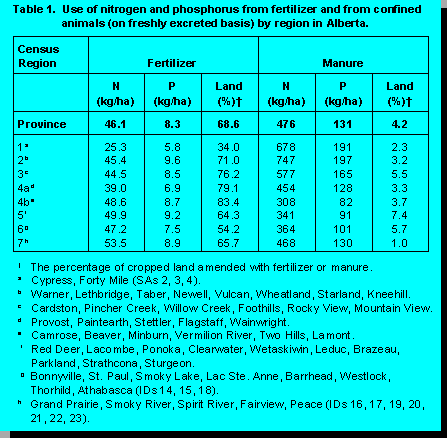 Two conclusions supported by the above
analysis are pertinent to a discussion of manure nutrient use. First, although the amount of N and
P purchased as fertilizer in Alberta is less than 2-fold more than that excreted as manure, fertilizer
is applied to more than 16-fold more land (Table 1). Thus, the amount of nutrients excreted per
area of land receiving manure is more than 10-fold higher than the average application of
fertilizer, resulting in potentially excessive losses of N and accumulations of P (Figure 2). Second,
the rate of manure nutrient addition exceeds that from fertilizer in all regions in Alberta.
Although the estimated excretion per unit of land receiving manure tends to be higher in
the southern regions, even in Region 4b with the lowest rate of manure application,
manure N exceeds that from fertilizer by 6.4-fold and manure P exceeds that from
fertilizer by 9.4-fold. It appears, then, that the large amounts of manure nutrients
potentially available for recycling in Alberta generally are spread on relatively small areas
of land.
Two conclusions supported by the above
analysis are pertinent to a discussion of manure nutrient use. First, although the amount of N and
P purchased as fertilizer in Alberta is less than 2-fold more than that excreted as manure, fertilizer
is applied to more than 16-fold more land (Table 1). Thus, the amount of nutrients excreted per
area of land receiving manure is more than 10-fold higher than the average application of
fertilizer, resulting in potentially excessive losses of N and accumulations of P (Figure 2). Second,
the rate of manure nutrient addition exceeds that from fertilizer in all regions in Alberta.
Although the estimated excretion per unit of land receiving manure tends to be higher in
the southern regions, even in Region 4b with the lowest rate of manure application,
manure N exceeds that from fertilizer by 6.4-fold and manure P exceeds that from
fertilizer by 9.4-fold. It appears, then, that the large amounts of manure nutrients
potentially available for recycling in Alberta generally are spread on relatively small areas
of land.
Knowledge of nutrient cycling allows further interpretation of these data. Most of the
excreted N likely is lost during storage and handling; indeed, the draft Code of Practice (7)
assumes this to be the case for open feedlot conditions. Where manure N is added to
soil in excess of plant requirements, further losses would be expected after application
and incorporation. 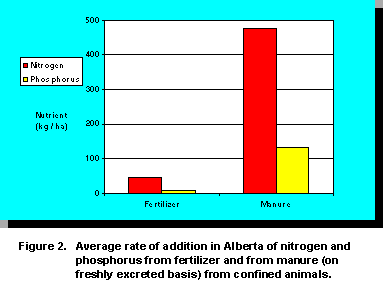 Accumulations of
readily available N in soil drive processes such as
ammonia volatilization, nitrification (conversion of ammonia to nitrate), leaching and,
where these accumulations occur with soluble carbon as is the case in manure,
denitrification (conversion of nitrate to nitrogen-containing gases). Conversely, P tends to
be conserved; P is not lost as gas and is not readily leached. The majority of the excreted
P, then, would be retained and consequently would accumulate where the manure is
spread. Losses of N and accumulations of P both represent ineffective use, or waste, of
manure nutrients.
Accumulations of
readily available N in soil drive processes such as
ammonia volatilization, nitrification (conversion of ammonia to nitrate), leaching and,
where these accumulations occur with soluble carbon as is the case in manure,
denitrification (conversion of nitrate to nitrogen-containing gases). Conversely, P tends to
be conserved; P is not lost as gas and is not readily leached. The majority of the excreted
P, then, would be retained and consequently would accumulate where the manure is
spread. Losses of N and accumulations of P both represent ineffective use, or waste, of
manure nutrients.
![]() Estimated Value of Manure
Nutrients
Estimated Value of Manure
Nutrients
The value of these manure nutrients can be assessed in two ways. First, economic value can be assessed in terms of equivalent amount of fertilizer nutrients. At the time of writing, the cost of urea fertilizer (46-0-0) was about $295 per tonne, and that of ammonium phosphate (11-51-0) was about $400 per tonne. This converts to a value of $640 per tonne of N and $1,450 per tonne of P. A typical dairy cow thus excretes about $70.00 worth of N and P annually. And, the estimated value of the nutrients excreted in 1991 by confined livestock in Alberta is $167 million. Using the same conversion, the fertilizer sold in 1991 would have a value of $280 million. Second, the environmental value of manure nutrients can be assessed according to the energy consumption and greenhouse gas emission associated with manufacturing and distributing substitute nutrients. The industrial production of a tonne of N as urea fertilizer requires 1700 m3 of natural gas and results in the emission of 3.4 tonnes of carbon dioxide (2). Thus, if we limit our consideration only to the manufacture of fertilizer N, effective use of the N excreted by confined animals in 1991 would save 270 million m3 of natural gas and 540,000 tonnes of carbon dioxide. Mining, transporting and processing P-containing ore requires fossil fuel energy, and hence use of manure P would accrue further environmental value. Of course, using manure also requires some energy, resulting in emissions of greenhouse gases . Analysis, therefore, of the total environmental cost of using manure compared to manufacturing and distributing fertilizer would be instructive. It may also be possible to attach economic value to these environmental benefits; perhaps, for example, the users of manure could be entitled to carbon credits which could be sold to enterprises that emit greenhouse gases . The potential value of manure resources is therefore substantial. The premise of our presentation is that, to capture this potential, livestock producers need to treat manure as a resource as a product to be harvested and marketed.
![]() Implications for the Dairy
Sector
Implications for the Dairy
Sector
How does this general analysis of manure management in Alberta relate to the dairy sector? In 1991, dairy cows and heifers excreted an estimated 9200 tonnes of N and 2200 tonnes of P, about 6% of the total manure N and P from confined livestock in Alberta. Our aim, therefore, is not to argue that dairy farms have a large volume of manure to manage; rather, we are convinced that dairy producers have exceptional opportunity to derive economic benefit from manure resources.
The majority of dairy enterprises in Alberta already have in place some elements of an effective manure management program. First, according to a survey by Alberta Agriculture, Food and Rural Development (5), 75% of dairy producers test their forages. This knowledge of forage nutrients allows design of rations to optimize recovery of nutrients in milk. According to the same survey, however, 85% of dairy enterprises import forages or concentrates or both, thus increasing the possibility of nutrient accumulations. Second, most dairy cows in Alberta are housed in free stall facilities with liquid manure handling systems. These facilities minimize exposure of manure to air and runoff water, and increase opportunities to harvest manure resources by implementing technologies such as methane production (1). The capacity of such systems to retain nutrients, however, means that a relatively large land base for manure application is recommended (7), ranging from 1.34 ha of Brown and Dark Brown soils to 0.67 ha of irrigated soils per milking cow. Thus, dairy farms require large areas of land to spread manure, but superior control over feed and manure resources increases opportunities for dairy enterprises to implement alternative manure management technologies.
It is also important to note, however, in 1991 Region 5 contained 41% of the dairy cows in Alberta and had the highest percentage (7.4%) of cropped land receiving manure. At that time Region 5, which accounts for about 13% of the cropped land in Alberta, also contained 20% of beef cows, 18% of feeder cattle, 26% of pigs and about 24% of poultry production in the province. Jeffrey (15) concludes that dairy enterprises are under economic pressure to increase in size. The beef and swine sectors are expanding in Alberta. Thus, unless technologies to improve use of manure are implemented, the predicted expansion in the livestock sector may further decrease the effective recycling of manure nutrients. Indeed, municipalities implementing the draft Code of Practice could constrain expansion if the producers control insufficient land on which to spread manure.
Composting to Improve Use of Manure Nutrients
![]() Potential Benefits of Composting
Potential Benefits of Composting
Our research aims to investigate composting as a technology to enhance recycling of manure nutrients. In composting, thermophilic ("heat-loving") aerobes (oxygen-requiring microorganisms) convert organic material into a biostable product. Three aspects of the composting process are relevant with respect to the potential for this technology to improve the use of manure nutrients in Alberta.
1. Microbial growth during composting releases carbon dioxide and water, thereby deceasing by 40 to 60% the mass of manure that must be transported. Unfortunately, the same biological processes that can cause losses in instances of nutrient accumulations in soil also can cause nutrient losses during composting. With appropriate process controls, however, these losses can minimized. The aim of our current research is to investigate the retention of N during composting or landspreading of raw manure. Variables being investigated include: (i) compost aeration rate; (ii) loss of N as ammonia or nitrous oxide (a 'greenhouse gas'); (iii) water-soluble N content of manure and compost; and, (iv) sorption, and conversely leaching, of water- soluble constituents of manure and compost by soils.
2. Finished compost is biostable, meaning that it is metabolized less rapidly by microorganisms than was the original organic material. At this stage, the fast-growing thermophilic microbes have used up the simple manure compounds and have decreased in number, being replaced by slower-growing microbes with the capacity to degrade more complex compounds. The biostable product can be stored until spread or sold, and can be amended with fertilizer to meet prescribed needs. Furthermore, batches of stored compost could be mixed to obtain an inventory of relatively homogeneous material.
3. Scientific evidence supports the conclusion that compost, produced to rigorous specifications, can suppress some plant diseases (12,17). Thus, as well as benefits achieved by adding manure, such as improved nutrient status and physical soil characteristics, compost amendment can provide additional benefits to soil-plant productivity. To convert these potential benefits into increased value for manure, their contribution to production profitability must be evaluated and, if positive, clearly demonstrated to consumers. It is reasonable nevertheless to conclude that the potential exists to obtain value for composted manure that exceeds the value of equivalent fertilizer nutrients.
![]() Cost of Composting
Cost of Composting
The cost of farm-scale composting was evaluated at a cattle feedyard in southern Alberta
(Table 2, data from 6). The $17.00 per tonne cost of production was based on a volume
of 600 tonnes of manure and a hauling distance of 24 km. 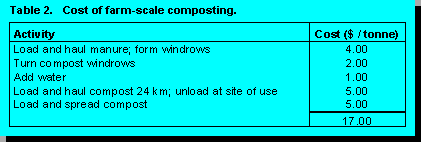 It is reasonable to propose that a significantly lower cost of
production could be achieved with a larger scale operation. This estimate also included costs
associated with any system of handling solid manure, such as moving the manure out of the pens.
Further studies are required to investigate the cost of composting compared to traditional handling
of solid and liquid manures. Even with this level of cost, however, the authors of the report
concluded that composting manure increases its economic delivery distance 15-fold.
It is reasonable to propose that a significantly lower cost of
production could be achieved with a larger scale operation. This estimate also included costs
associated with any system of handling solid manure, such as moving the manure out of the pens.
Further studies are required to investigate the cost of composting compared to traditional handling
of solid and liquid manures. Even with this level of cost, however, the authors of the report
concluded that composting manure increases its economic delivery distance 15-fold.
We are not promoting composting as "The Solution" other strategies have been demonstrated to extract benefit from manure resources. The AgSTAR Program, for example, reports that collection of methane from manure digestion at a 500-cow dairy has decreased annual operation and maintenance costs by US$53 000, an annual return on investment of 21% (1). The AgSTAR Program is a partnership between livestock producers and three arms of the United States government Environmental Protection Agency, Department of Agriculture, and Department of Energy. The focus of our presentation is thus parallel to the philosophy of the AgSTAR program; namely, "AgSTAR regards manures as resources capable of improving profits and the cornerstone of an interagency pollution prevention strategy".
Marketing Composted Manure
Convincing consumers of the value of compost has, at least, two components. First, potential consumers of compost must be identified. Retail markets for bagged compost exist, but these are nearly saturated and are much smaller than agricultural markets (4). Agricultural markets, however, have a small margin and are driven strongly by evidence of economic benefit. Obtaining such evidence likely will require research funded by livestock producers. Second, standards of compost quality must be specified clearly and followed rigorously. Because the benefits of compost have biological, chemical and physical aspects, standards should address all of these characteristics of compost (8,13). To be successful, then, marketing compost will require integration of technical knowledge with financial analysis.
Having convinced consumers of the value of high quality compost, it remains to deliver it to them. In a commentary for BioCycle magazine, G.E. d'Aquin proposed that the network of fertilizer dealers serving commercial agriculture could be used to develop and supply an agricultural market for composted manure (9). As evidence that such an arrangement is feasible, d'Aquin gives the example of an "organically enhanced fertilizer" containing composted poultry litter and fertilizer, marketed by Crop Production Services of Tulsa, Oklahoma. This opportunity to market animal manures through the retail fertilizer chain is also under consideration by the Potash & Phosphate Institute, an organization of fertilizer producers in Canada and the United States (10).
![]() Edmonton Recycling Society -- An Example of
Converting Wastes into Commodities
Edmonton Recycling Society -- An Example of
Converting Wastes into Commodities
The power of imaginative effort in the realm of sustainability is illustrated by the success of
the Edmonton Recycling Society. The critics in 1989 of the Society's proposal to recycle
"wastes" used the same arguments so often directed at proposals to enhance the
sustainability of manure management: "The market for these materials is too small",
"They are too expensive to transport", "It's cheaper to dispose than to recycle", "There is
no real problem the current perception is just a fad". Despite these predictions,
revenues have increased every year (Figure 3, data from 11), even though the volume
has remained constant at about 10 000 tonnes per year. The Society attributes this
success to the development of local markets and attention to the demands of these
markets. For example, in 1989, 85% of the recycled materials were sold to off-shore
consumers; potential revenues were eaten up by transportation costs. Today, 97% of the
materials are sold in the Edmonton trading area.
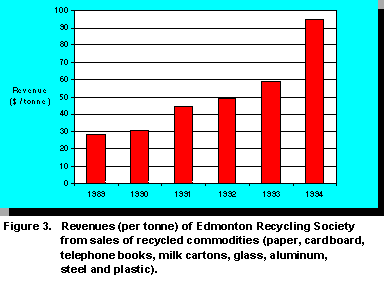
The Edmonton Recycling Society is not a lucrative enterprise. Similarly, enhancing the sustainability of manure management likely will not accrue large profits to livestock producers. To realize any profit, however, where formerly only a cost was incurred, is potentially a significant net gain. We submit that innovative resource managers can integrate animal production and the environment to enhance environmental and economic sustainability.
References